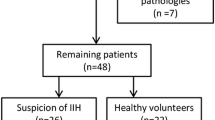Abstract
Background
Optical coherence tomography (OCT) enables quantification of retinal layer thicknesses. Studies evaluating the ability of OCT to identify and quantify papilledema are few. Therefore, the aim was to evaluate the applicability of peripapillary OCT evaluation in an unselected, consecutive series of patients with confirmed idiopathic intracranial hypertension (IIH).
Methods
A case-control study of 20 patients with newly diagnosed IIH and 20 healthy subjects. Subjects were evaluated by means of direct ophthalmoscopy, masked evaluations of fundus photography, peripapillary retinal nerve fiber layer thickness (RNFLT), and peripapillary average retinal thickness (PART) measurements (Stratus OCT-3, fast RNFL 3.4 protocol).
Results
OCT evaluation of PART revealed the highest number of patients (n = 20) with optic disc abnormalities in either eye (90%), compared with 85%, 80% and 70% for RNFLT measurements, direct ophthalmoscopy, and fundus photography respectively. There was a linear association between means and differences of OCT data (RNFLT, PART) with a slope of 0.54 (SE 0.025), p < 0.001.
Conclusion
Peripapillary OCT is a promising objective examination modality for optic disc evaluation in IIH, and may improve the identification of subtle disc swellings. Underestimation of RNFLT for increasing severities of papilledemas is suspected, making PART a more reliable parameter compared to RNFLT. Future larger validation studies are needed.



Similar content being viewed by others
References
Headache Classification Subcommittee of the International Headache Society (2004) The International Classification of Headache Disorders, 2nd edition. Cephalalgia 24(suppl 1):9–160
Friedman DI, Jacobson DM (2002) Diagnostic criteria for idiopathic intracranial hypertension. Neurology 59:1492–1495
Skau M, Brennum J, Gjerris F, Jensen R (2006) What is new about idiopathic intracranial hypertension? An updated review of mechanism and treatment. Cephalalgia 26:384–399
Digre KB, Nakamoto BK, Warner JEA, Langeberg WJ, Baggaley SK, Katz BJ (2009) A comparison of idiopathic intracranial hypertension with and without papilledema. Headache 49:185–193
Huang D, Swanson EA, Lin CP, Schuman JS, Stinson WG, Chang W, Hee MR, Flotte T, Gregory K, Puliafito CA (1991) Optical coherence tomography. Science 254(5035):1178–1181
Schuman JS, Hee MR, Puliafiro CA, Wong C, Pedut-Kloizman T, Lin CP, Hertzmark E, Izatt JA, Swanson EA, Fujimoto JG (1995) Quantification of nerve fiber layer thickness in normal and glaucomatous eyes using optical coherence tomography. Arch Ophthalmol 113(5):586–596
Contreras I, Noval S, Rebolleda G, Munoz-Negrete FJ (2007) Follow-up of nonarteritic anterior ischemic optic neuropathy with optical coherence tomography. Ophthalmology 114:2338–2344
Kallenbach K, Frederiksen J (2007) Optical coherence tomography in optic neuritis and multiple sclerosis: a review. Eur J Neurol 14:841–849
Barboni P, Savini G, Valentino ML, Montagna P, Cortelli P, De Negri AM, Sadun F, Bianchi S, Longanesi L, Zanini M, de Vivo A, Carelli V (2005) Retinal nerve fiber layer evaluation by optical coherence tomography in Leber’s hereditary optic neuropathy. Ophthalmology 112:120–126
Menke MN, Feke GT, Trempe CL (2005) OCT measurements in patients with optic disc edema. Invest Ophthalmol Vis Sci 46:3807–3811
Savini G, Bellusci C, Carbonelli M, Zanini M, Carelli V, Sadun AA, Barboni P (2006) Detection and quantification of retinal fiber layer thickness in optic disc edema using stratus OCT. Arch Ophthalmol 124:1111–1117
Johnson LN, Diehl ML, Hamm CW, Sommerville DN, Petroski GF (2009) Differentiating optic disc edema from optic nerve head drusen on optical coherence tomography. Arch Ophthalmol 127:45–49
Karam EZ, Hedges TR (2005) Optical coherence tomography of the retinal nerve fibre layer in mild papilloedema and pseudopapilloedema. Br J Ophthalmol 89:294–298
El-Dairi MA, Holgado S, O’Donnell T, Buckley EG, Asrani S, Freedman SF (2007) Optical coherence tomography as a tool for monitoring pediatric pseudotumor cerebri. J AAPOS 11:564–570
Rebolleda G, Munoz-Negrete FJ (2009) Follow-up of mild papilledema in idiopathic intracranial hypertension with optical coherence tomography. Invest Ophthalmol Vis Sci 50(11):5197–5200
Pons ME, Garcia-Valenzuela E (2005) Redefining the limit of the outer retina in optical coherence tomography scans. Ophthalmology 112:1079–1085
Hee MR, Puliafito CA, Duker JS, Reichel E, Coker JG, Wilkins JR, Schuman JS, Swanson EA, Fujimoto JG (1998) Topography of diabetic macular edema with optical coherence tomography. Ophthalmology 105(2):360–370
Frisen L (1982) Swelling of the optic nerve head: a staging scheme. J Neurol Neurosurg Psychiatry 45:13–18
Bland JM, Altman DG (1986) Statistical methods for assessing agreement between two methods of clinical measurement. Lancet 1(8476):307–310
Spence JD, Amacher AL, Willis NR (1980) Benign intracranial hypertension without papilledema: role of 24-hour cerebrospinal fluid pressure monitoring in diagnosis and management. Neurosurgery 7:326–336
Vieira DS, Masruha MR, Goncalves AL, Zukerman E, Senne Soares CA, Naffah-Mazzacoratti Mda G, Peres MF (2008) Idiopathic intracranial hypertension with and without papilledema in a consecutive series of patients with chronic migraine. Cephalalgia 28:609–613
Torbey MT, Geocadin RG, Razumovsky AY, Rigamonti D, Williams MA (2004) Utility of CSF pressure monitoring to identify idiopathic intracranial hypertension without papilledema in patients with chronic daily headache. Cephalalgia 24:495–502
Wang SJ, Silberstein SD, Patterson S, Young WB (1998) Idiopathic intracranial hypertension without papilledema. A case-control study in a headache center. Neurology 51:245–249
Mathew NT, Ravishankar K, Sanin LC (1996) Coexistence of migraine and idiopathic intracranial hypertension without papilledema. Neurology 46:1226–1230
Pro MJ, Pons ME, Liebmann JM, Ritch R, Zafar S, Lefton D, Kupersmith MJ (2006) Imaging of the optic disc and retinal nerve fiber layer in acute optic neuritis. J Neurol Sci 250:114–119
Hayreh SS (1977) Optic disc edema in raised intracranial pressure. V. Pathogenesis. Arch Ophthalmol 95:1553–1565
Wall M, White WN (1998) Asymmetric papilledema in idiopathic intracranial hypertension: prospective interocular comparison of sensory visual function. Invest Ophthalmol Vis Sci 39:134–142
Acknowledgments
Supported by The Research Foundation of the Capital Region, the VELUX foundation and the John and Birthe Meyer Foundation.
Author information
Authors and Affiliations
Corresponding author
Additional information
No conflict of interest. Authors have full control of all primary data, and agree to allow Graefe's Archives for Clinical and Experimental Ophthalmology to review data upon request.
Rights and permissions
About this article
Cite this article
Skau, M., Milea, D., Sander, B. et al. OCT for optic disc evaluation in idiopathic intracranial hypertension. Graefes Arch Clin Exp Ophthalmol 249, 723–730 (2011). https://doi.org/10.1007/s00417-010-1527-2
Received:
Revised:
Accepted:
Published:
Issue Date:
DOI: https://doi.org/10.1007/s00417-010-1527-2




